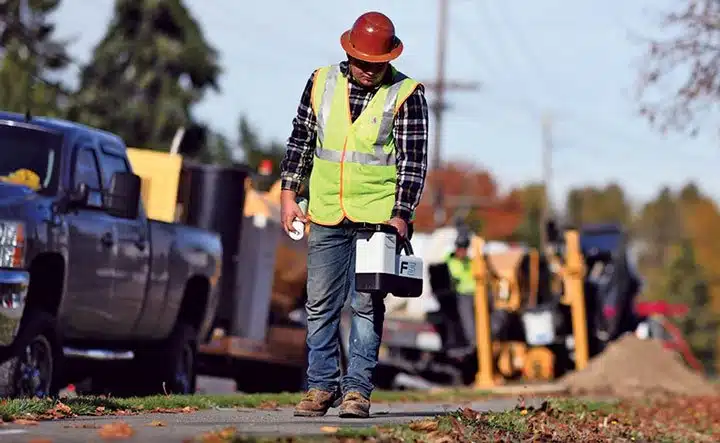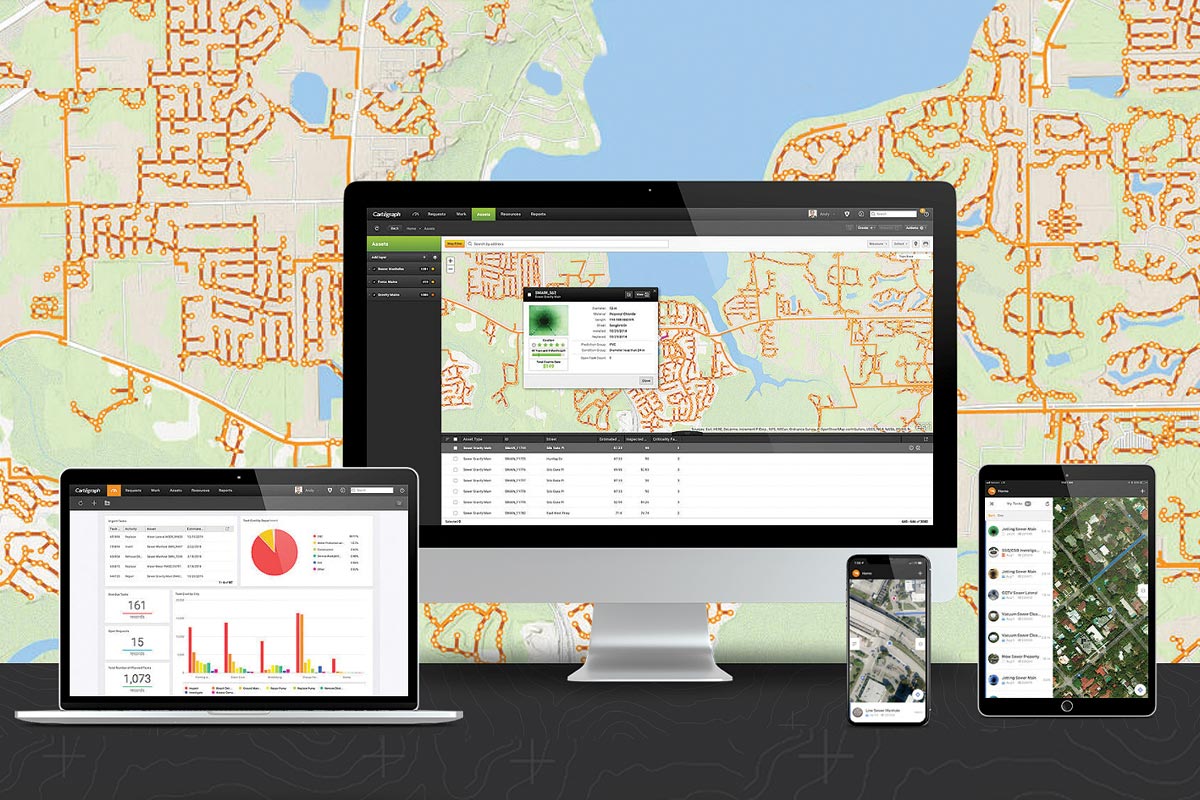
Walkover Locating Systems: The Brains of the HDD Operation

Contractors are looking for products such as DCI’s Falcon 5 System, that are aimed at solving the issue of active interference.
On a HDD project site, each piece of equipment has an important role to complete a successful project. Let’s face it, the star of the show is the horizontal drill rig — maxi or compact. Drilling fluid is the lifeblood that flows through the borehole and the drill pipe is the unsung hero, getting virtually no accolades in the final review but is the piece that gets down and dirty.
What about the walkover locating system? This must-have tool can easily be described as the brains of the operation, keeping HDD crewmembers on track as the bore weaves its way to the exit point, avoiding interference, buried utilities and other obstacles along the way. Kind of like a compass but way cooler and more high tech.
A locating system certainly isn’t the biggest piece of equipment but it is jampacked with software that is, in effect, the most critical piece to securing a successful project. All locating experts point out that the first D in HDD stands for “directional,” making horizontal directional drilling near impossible to do without a locating system.
RELATED: A ‘Wireline’ Bore In Heavy Interference — Without A Wire
However, today’s systems do so much more than just lead HDD operators to the exit hole. These systems — ranging in price from $10,000 to $25,000-plus — include a multitude of features such as annualar fluid pressure readings, datalogging, and GPS data target of off-track guidance, among others — producing invaluable information to operators that their earliest models, did not and could not. The software can even be connected to the operator’s smartphone.
“The ability to safely, accurately and efficiently guide the pilot bore in the presence of various kinds of interference or other obstacles is where a good locating system is the difference between success and failure.”
That assessment comes from Digital Control Inc. (DCI) product manager Siggi Finnsson, who has been a part of the HDD industry, and specifically the locating market, for more than 20 years. DCI’s known for its DigiTrak system, which has evolved over several models. In recent years, the company has introduced its DigiTrak Falcon series of locators aimed specifically at solving the problem of active interference. The Falcon F5 system addresses both active and passive interference using a single wideband transmitter employing hundreds of frequencies. The Falcon F5 provides datalog with the iGPS module and annular fluid pressure measurements. The drill logs can then be uploaded to the cloud using the LWD mobile app making the communication and documentation of drill data much more efficient.
We asked Finnsson and a few other locating experts for their perspective on today’s HDD locating system consumer. Just how savvy are they? What are they looking for when buying a new locating system or adding to their fleet?
“Contractor knowledge has changed drastically with the evolution of the Internet and real-time availability of information. It is not uncommon to start a conversation or training on a topic and five minutes in, the customers are watching Youtube videos,” says Subsite Electronics HDD product manager Levi Valdois. “In my opinion, the availability of information has created a more informed customer who is automatically asking about more advanced features and benefits of our product.”
This knowledge at their fingertips also gives the customer access to other products in the locating marketplace, allowing for a better conversation between them and the manufacturer they are dealing with.
Finnsson agrees with Valdois about the proliferation of information through social media channels, such as Youtube and websites. He adds, “As systems have become more advanced, the contractors necessarily have had to better understand their own requirements. They need to evaluate project requirements, which themselves are becoming more complex against feature sets. Ten or 20 years ago, that was a simpler exercise given that the equipment was much simpler.”
During the 1990s and the early growth of the HDD industry, the locating market had a larger pool of manufacturers to choose from when shopping for a system. Today, the market is a much smaller scale but just as competitive. The common thread that ties these different HDD eras together continues to be the customer service they provide to customers.
“That need for customer support is still one of the main questions asked when purchasing a new locating system,” says Underground Magnetics Inc. president Mike Young, known in locating circles from his many years with DCI. “Having quality training through dealers and distributors, loaner units as needed and product in stock to handle customer needs is very important.”
RELATED: Directional Drilling: Tracking and Guiding 101
Young says companies like Underground Magnetics give contractors who just want a simple locating system to get from Point A to Point B another option outside the “big boys” of locators. Underground Magnetics offers its Mag 6 system, which includes 190-ft depth capability, ability to change frequencies and power down hole, as well as a mapping system that will give left right GPS accuracy down to 3 in.

Walkover locating systems have come a long way in development over the last 20 years, such as Subsite’s TK Recon 4, with more features to provide more information.
Locating Evolution
But what are contractors wants and needs? Today, a lot of information and data is packed in that small unit.
Off the top, the key features that contractors demand from a product include accuracy, durability, reliability and ease of use.
“Contractors are looking for a variety of features, as you know each jobsite is different,” says Valdois. “Requirements on a very basic jobsite center around ease of use, speed, safety and accuracy. Many of our customers are performing multiple jobs every day and they want the best equipment available that can help them capitalize their time and resources day in and day out.”
But they also want more, such as as-built reports that include GPS coordinates and multiple file types that can be imported into high end engineering CAD programs. “Contractor needs have evolved from simply installing product with very limited information available such as roll and signal strength to having to think of the entire jobsite,” Valdois says.
As an example of the what systems can do, Valdois references Subsite’s TK Recon 4, its latest model. This system includes features such as Drill-to, Bore Path Analyzer, Bore Logging, integrated compass and the ability to communicate with multiple past and current Subsite beacons. Add in the Field Scout mobile solution to the process and you have the capabilities of the Subsite Green Ops and the ability to leverage planning, boring and reporting to maximize the limited time and resources that contractors have to complete each job.
Contractors want to be able to change frequencies and power in the ground to help overcome obstacles. Accuracy is even more critical today as the easements become more congested, having only a few inches left and right to place their product. The new antenna designs of the last few years have given this accuracy to the industry,” Young says.
RELATED: Planning Under Way for 2018 HDD Academy
The experts also note the contractors’ need for more power and depth capability to be able to bore through already congested areas more easily. Finnsson adds that the capability to handle interference is also a must; the DCI Falcon technology allows the contractor to scan the jobsite for interference over a broad spectrum and uses that information to optimize the best two frequencies from the hundreds available.
Finnsson marvels at how far locating systems have come over the last 20 years and even just the last few years. “As the HDD industry has matured, the requirements placed on locating equipment have increased.
The ability to handle ever increasing amounts and kinds of interference, the ability to go increasingly deeper, increased productivity through features such a target steering, logging pertinent bore data using the locators, connecting a locator to smart phone apps, logging GPS data with a locator are some of the must haves today. Even the base systems today offer significant advancements over systems of a few years ago,” he says.
This need for more software, more capabilities and more everything drives the locating market to new heights in short spans of time. Today’s locators are not that different from today’s computers in that they can become obsolete over a few years.
“A good locating system, if taken care of is going to last a considerable amount of time,” Valdois says. “Typically, what we have seen is that jobsite requirements and technology surpass the product capability, it’s not a matter of the system wearing out or breaking it tends to be a matter of the system becoming obsolete because of the rapid pace of technology advancement in our industry.”
Sharon M. Bueno is managing editor of Trenchless Technology.




